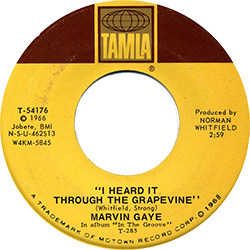The Life of a Song: ‘I Heard It Through the Grapevine’

Simply sign up to the Life & Arts myFT Digest -- delivered directly to your inbox.
Motown boss Berry Gordy had a quality control department for deciding whether a song should be released. “If you had only enough money for this record or a sandwich,” he would ask staff, producers and writers at the hit factory, “which would you buy?” Or he would play a song through a rigged-up car stereo system to test how it might sound going down the highway. It worked, producing hit after hit.
Sometimes, however, the department missed the best. In 1966 singer-songwriter Barrett Strong came up with an idea for a song based on the expression “through the grapevine” that he kept hearing on the streets of Chicago. The phrase had its roots in the days of the slave trade. The “grapevine telegraph” had been the system of communication used by slaves during the American civil war. Prohibited from learning to read, they passed on news by word of mouth.
Strong took his song to Motown producer Norman Whitfield. Together they worked it up into “I Heard It Through the Grapevine”, a dramatic tale of romantic betrayal. Whitfield recorded a version with The Miracles in 1966 but the Motown committee decided they’d rather buy a sandwich. The following year Marvin Gaye recorded it, but it was Gordy himself who vetoed it as a single. Eventually “Grapevine” was released by Gladys Knight and the Pips in 1967 in a new, more up-tempo arrangement. It was a hit, reaching number two in the charts.
Meanwhile, Gaye’s version was awaiting its moment. He had recorded the song over five sessions with a backing ensemble that included the Detroit Symphony Orchestra, with Whitfield pushing him to sing in a higher key than his normal range. The song made its way on to Gaye’s 1968 album In the Groove.

When the album was released, “Grapevine” was picked up by E Rodney Jones, a DJ at Chicago’s black community radio station WVON. After the song aired for the first time, Jones told Motown marketing man Phil Jones that “the phones lit up”. No wonder: listeners were gripped by the ominous intro, the bassline, the brass, the jittery piano, the restrained first-person narrative, the controlled anguish of Gaye’s voice. Motown, swayed by public opinion, released it as a single, and it became the label’s biggest-selling hit to date.
A couple of years later Creedence Clearwater Revival covered the song in an overblown 11-minute version for their album Cosmo’s Factory. But it was an English-based female punk band, The Slits, who gave the song its most radical reinterpretation. In tune with the spirit of the times, the Slits happily admitted that they could neither write songs nor play their instruments; nevertheless, they supported The Clash on tour and, in 1979, they were signed by Island Records. Reggae star Dennis Brown had been sent in to produce their first studio session but it became apparent that he did not know his way around the mixing desk.

The Slits gave Brown the boot, and found themselves in the studio with a woman called Rema who had come along with Brown’s entourage to help out and make the tea. Rema said she had a bit of studio experience and took over at the controls; together the women worked out how they wanted the song to sound, giving it a strong reggae vibe. They couldn’t afford a brass section, so they sang the horn parts. Then, behind 17-year-old German lead singer Ari Up’s vocals, they chanted “Grapevine, grapevine” over and over — using, as Slits guitarist Viv Albertine later said, “our real voices, not little-girl voices the way so many girls sing”.
This DIY production yielded a recording that’s wild, patched-together, ferocious, raw — a total contrast to Motown’s pop-factory classic.
For more in the series and podcasts with clips, visit ft.com/life-of-a-song
Photographs: Alamy; Getty Images
Listen to the podcast
Comments